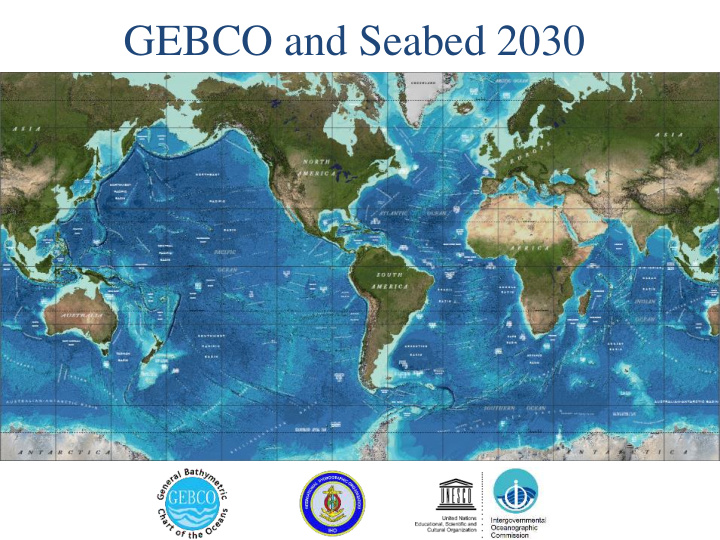



GEBCO and Seabed 2030
What is GEBCO? • GEneral Bathymetric Chart of the Oceans • An international group of experts who work on the development of a range of bathymetric data sets and data products • Aims to provide the most authoritative, publicly-available bathymetric data sets for the world’s oceans • Operates under the auspices of the International Hydrographic Organization (IHO) and the Intergovernmental Oceanographic Commission (IOC) of UNESCO • First GEBCO paper chart series initiated in 1903(!)
United Nations Educational Scientific and Cultural Organization International Hydrographic Intergovernmental Organisation Oceanographic Commission Guiding Committee Sub-Committee on Scientific Committee on Technical Sub-Committee on Regional Undersea Mapping Undersea Feature Ocean Mapping (TSCOM) (SCRUM) Names (SCUFN)
Regional mapping work GEBCO has setup the Sub-Committee on Regional Undersea Mapping (SCRUM) to: • Build a closer collaboration with regional mapping efforts and coordinate, as well as encourage, the incorporation of their compilations into GEBCO. • The Global GEBCO grid is continuously updated in part from these regional grids, benefiting greatly from their local knowledge and expertise . www.gebco.net/regional_mapping/mapping_projects/
GEBCO Products • Gridded Bathymetry (30 arc seconds) – Digital atlas – Maps, Charts, and Viewers Available at – Web Services https://www.gebco.net • Undersea Feature Names • Bathymetry Processing Cookbook
GEBCO’s products: Source Identifier Grid The GEBCO Source Identifier (SID) Grid: Shows the source of depth value in each grid cell, i.e. if it is based on trackline data; pre-existing grids or if it is based on interpolation
Seabed 2030 • A program to produce the definitive map of the World Ocean floor by 2030 to empower the world to make policy decisions, use the ocean sustainably, and undertake scientific research based on detailed information of the Earth’s seabed. • Supports United Nations Sustainable Development Goal 14: to conserve and sustainably use the world’s oceans, seas and marine resources SDG14 will be impossible to achieve without a comprehensive map of the world’s ocean floor
If the World Ocean is divided into 1x1 km blocks (grid cells), about 82% of them do not have depth values. (Based on GEBCO 2014 grid) 1 km
From……
To……
Seabed 2030: How we got here Mr Sasakawa, Chairman of the Nippon Foundation Proposed ‘…to map 100% of the topography of the World Ocean by 2030’ June 2016 Nippon Foundation - GEBCO Seabed 2030 Project announced June 2017 Mr Sasakawa – 1 of 8 IOC-UNESCO “Champions of Global Ocean Science” Project start 2030 100% of ocean accurately mapped 1 st August 2017
Project Plan • WP 1: Gathering, synthesizing, publishing bathymetric data – Merging all available data into the high resolution ocean map • WP 2: Development of standards, data assembly and delivery tools – Developing the tools and systems to facilitate building and using the map. • WP 3: Technology innovation – Identifying and encouraging technical innovation in bathymetric mapping • WP 4: Networking: map the gaps – Future mapping expeditions to increase the coverage • WP 5: Management – Managing the project
One Global Data Assembly and Coordination Centre (GDACC) and Four Regional Data Assembly and Coordination Centres (RDACC) will be established CCOM/JHC
WP 1: Gathering, compiling and publishing bathymetric data GEBCO-Nippon Foundation Seabed 2030 EB RDACC World Ocean Map EB GDACC RDACC WWW EB RDACC download services EB Users RDACC EB=Editorial Board for ocean regions Seabed 2030 storage of source data in DCDB WP 3: Technology innovation WP 2: Development of bathymetric WP 4: Mapping the gaps data and assembly tools Gridding tools Cloud Bathy Data processing -databases
Seabed 2030 project management
Seabed 2030 Key Documents https://seabed2030.gebco.net/
Filling the data gaps with bathymetry from ENC data • To more accurately model the shape of the ocean floor in all areas and serve a wider user community, GEBCO is striving to improve its gridded bathymetric datasets in shallower waters • In 2006 a request was made to IHO Member States to provide bathymetry data from ENCs (usage bands 2 and 3) to GEBCO to help update its global model • New request to IHO MS for bathymetry data from ENCs sent out in March 2016 (circular letter 11/2016)
Shallow water bathymetry from ENC data ENC data coverage (usage bands 2 & 3) provided by IHO MS and organizations, to date, to GEBCO for grid updating work after calls in 2006 (yellow) and 2016 (red),
Shallow water bathymetry from ENC data Data for waters off Brazil Soundings points extracted from ENCs recently supplied to GEBCO for the waters off Brazil
Shallow water bathymetry from ENC data Data for waters off Brazil
Capacity-building initiative: The Postgraduate Certificate in Ocean Bathymetry Designed to train a new generation of scientists and hydrographers in ocean bathymetry is funded by: The Nippon Foundation of Japan www.nippon-foundation.or.jp/en/ and taught at: The Center for Coastal and Ocean Mapping / Joint Hydrographic Center; University of New Hampshire, USA SEE CIRCULAR LETTER 13/2017 - 09 February 2017
78 scholars from 35 coastal states over last 13 years with the current class coloured red Add incoming Year 14 class (hatch) (84 people from 37 coastal states)
Training Program Content
For more information • GEBCO: https://www.gebco.net • Training: https://www.gebco.net/training/training_programme/ • Seabed 2030: https://seabed2030.gebco.net/ • Johnathan Kool (GEBCO GGC) – johnathan.kool@ga.gov.au
Recommend
More recommend